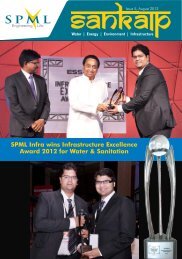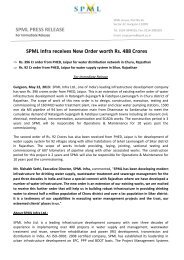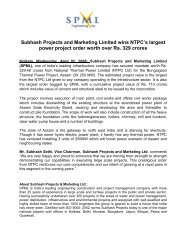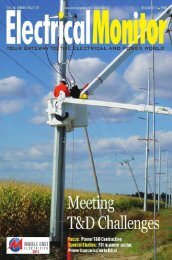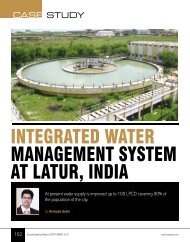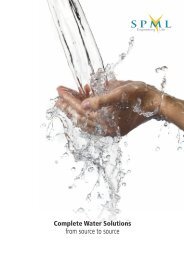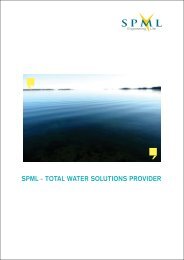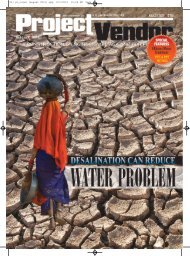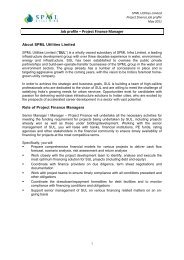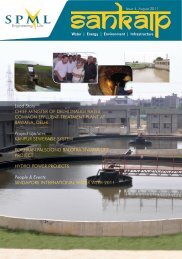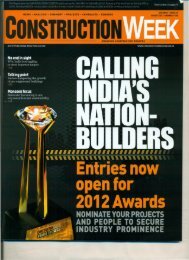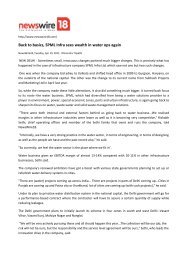You also want an ePaper? Increase the reach of your titles
YUMPU automatically turns print PDFs into web optimized ePapers that Google loves.
ANNUAL REPORT <strong>2009</strong>-<strong>10</strong><strong>SPML</strong> INFRA LIMITED & ITS SUBSIDIARIES (formerly Subhash Projects and Marketing Limited)SCHEDULES FORMING PART OF THE CONSOLIDATED BALANCE SHEET AND PROFIT & LOSS ACCOUNT3. Use of estimatesThe preparation of financial statements in conformity with generally accepted accounting principles requires management to make estimates andassumptions that affect the reported amounts of assets and liabilities and disclosure of contingent liabilities at the date of the financial statementsand the results of operations during the reporting period end. Although these estimates are based upon the management’s best knowledge ofcurrent events and actions, actual results could differ from these estimates.4. Changes in Accounting PoliciesInventory of materials and consumables at certain sites as at March 31, 20<strong>10</strong> have been valued at weighted average method which werehitherto valued on First in First out (FIFO) method. In the opinion of the management, the impact of the above change on the profit for theyear although not presently ascertainable, is not likely to be material.5. Fixed Assets(a) Fixed assets are stated at cost of acquisition inclusive of duties (net of CENVAT / VAT), taxes, incidental expenses, erection/commissioningexpenses upto the date the asset is ready to be put to use. In case of revaluation of fixed assets, the original cost as written up by the valueris considered in the accounts and the differential amount is transferred to revaluation reserve.(b) Machinery spares which can be used only in connection with an item of fixed assets and whose use as per technical assessment is expectedto be non-regular are capitalized and depreciated prospectively over the useful life of the respective assets.(c) The carrying amount of assets is reviewed at each balance sheet date to determine if there is any indication of impairment thereof based onexternal/internal factors. An impairment loss is recognized wherever the carrying amount of an asset exceeds its recoverable amount, whichrepresents the greater of the net selling price of assets and their ‘value in use’. The estimated future cash flows are discounted to their presentvalue at appropriate rate arrived at after considering the prevailing interest rates and weighted average cost of capital.6. Depreciation / AmortisationDepreciation on fixed assets is provided using the Straight Line Method at the rates prescribed under Schedule XIV of the Companies Act, 1956,except in case of Delhi Waste Management Limited, a subsidiary, where depreciation is provided using Straight Line Method over a period of nineyears being the concession period as per the Concession Agreement with the Principal.In case of Fixed Assets which are revalued, the provision for depreciation is based on the revalued amount on the estimate of the remaining usefullife of such assets.In case of impairment, if any, depreciation is provided on the revised carrying amount of the assets over their remaining useful life.Assets costing Rs.7,500 or less are depreciated @<strong>10</strong>0% in the year of purchase.Intangible assets (specialised software) are amortised using the straight line method over a period of five years.Goodwill arising on consolidation is stated at cost and impairment, if any, is recognised.7. LeasesLeases where the lessor effectively retains substantially all the risks and benefits of ownership of the leased assets, are classified as operating leases.Operating lease payments are recognized as an expense in the Profit and Loss account on a straight-line basis over the lease term.8. InvestmentsInvestments that are readily realisable and intended to be held for not more than a year are classified as current investments. All other investmentsare classified as long-term investments. Current investments are carried at lower of cost and fair value determined on individual investmentbasis. Long term investments are considered at cost, unless there is an “other than temporary” decline in value thereof, in which case, adequateprovision for diminution is made in the accounts.9. InventoriesRaw Materials, components, stores and spares to be used in contracts are valued at cost which is ascertained on First in First out (FIFO) / weightedaverage basis. Materials, components and stores and spares at wind farms and other manufacturing activities are valued at lower of cost and netrealisable value.Stock of finished goods and goods under process are valued at estimated cost (inclusive of excise duty on purchase) or net realisable value,whichever is lower.87



